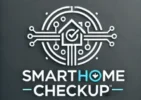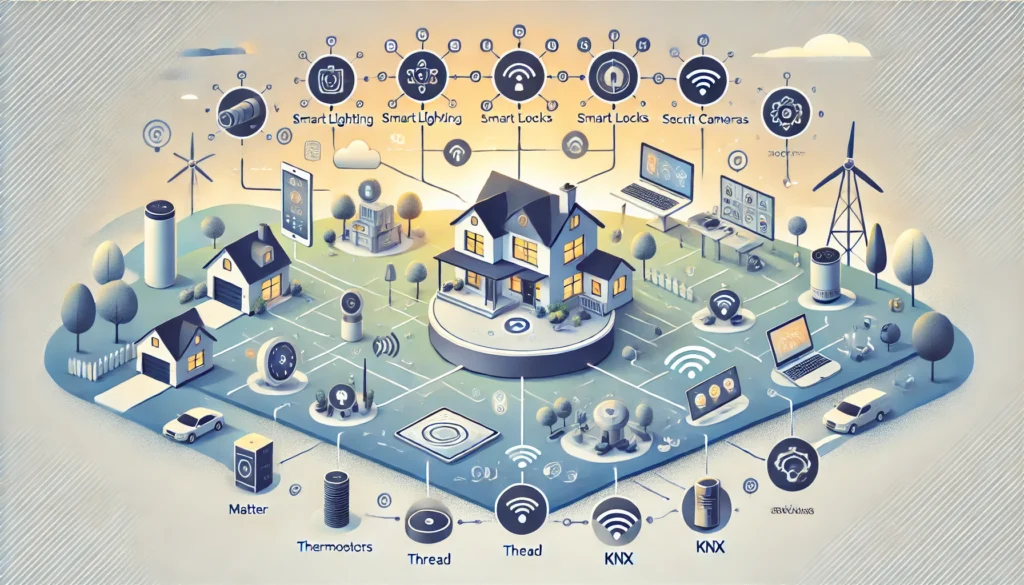
Glossary
- Application Layer: The top layer in the network protocol stack where user-interface and application processes reside.
- Interoperability: The ability of different systems or devices to work together seamlessly without special effort from the user.
- IoT (Internet of Things): A network of physical objects embedded with sensors, software, and other technologies to connect and exchange data.
- KNX: A standardized protocol for building automation, particularly known for wired installations.
- Matter: An application layer protocol aiming to unify smart home device communication.
- Mesh Networking: A network topology where devices (nodes) connect directly and non-hierarchically to as many other nodes as possible.
- Network Layer: Handles the routing of data packets between devices on different networks.
- Protocol: A set of rules governing the exchange or transmission of data between devices.
- Thread: A network layer protocol designed for low-power IoT devices, utilizing mesh networking.
- IP (Internet Protocol): A set of rules governing the format of data sent over the internet or local network.
- IEEE 802.15.4: A technical standard that defines the operation of low-rate wireless personal area networks (LR-WPANs).
Introduction
The smart home landscape is undergoing a significant transformation. With the advent of new technologies and standards, devices are becoming more interconnected, intelligent, and user-friendly. Matter, Thread, and KNX are at the forefront of this revolution, each playing a crucial role in shaping the future of home automation. This article delves into these standards, exploring their technical underpinnings, use cases, challenges, and how they collectively enhance your smart home experience.
The Evolving Landscape of Smart Home Connectivity
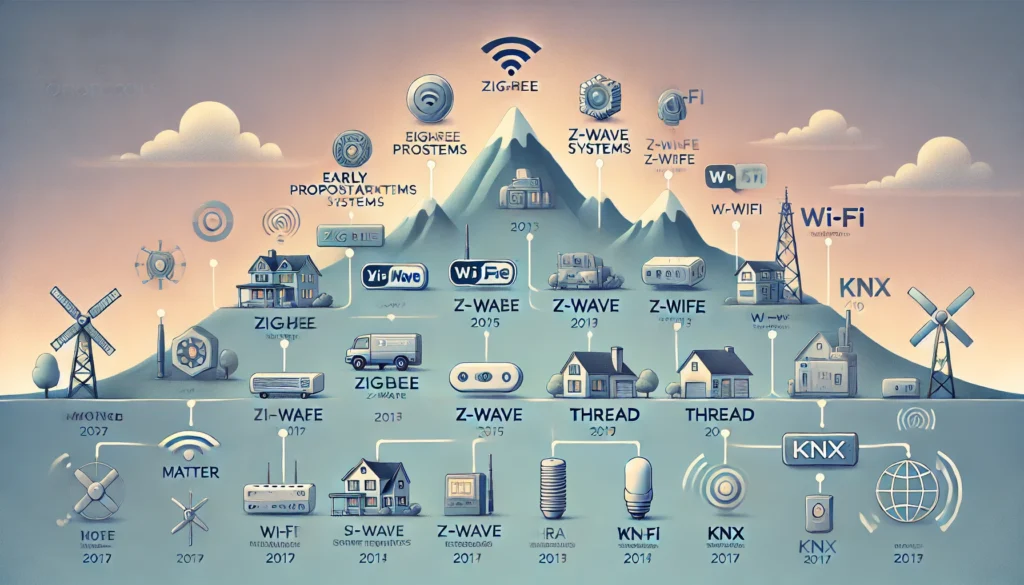
A timeline showcasing the progression of smart home connectivity protocols.
The proliferation of smart devices has led to a fragmented ecosystem where compatibility and interoperability are constant challenges. Devices from different manufacturers often require separate apps or hubs, creating a complex and sometimes frustrating user experience.
Importance of Interoperability and Unified Standards
Unified standards are essential for simplifying smart home setups. They enable devices to communicate regardless of brand or platform, fostering an ecosystem where users can mix and match devices to suit their needs without worrying about compatibility issues. Interoperability not only enhances user convenience but also drives innovation by allowing manufacturers to focus on creating better products rather than proprietary ecosystems.
Matter: The Universal Language of Smart Devices
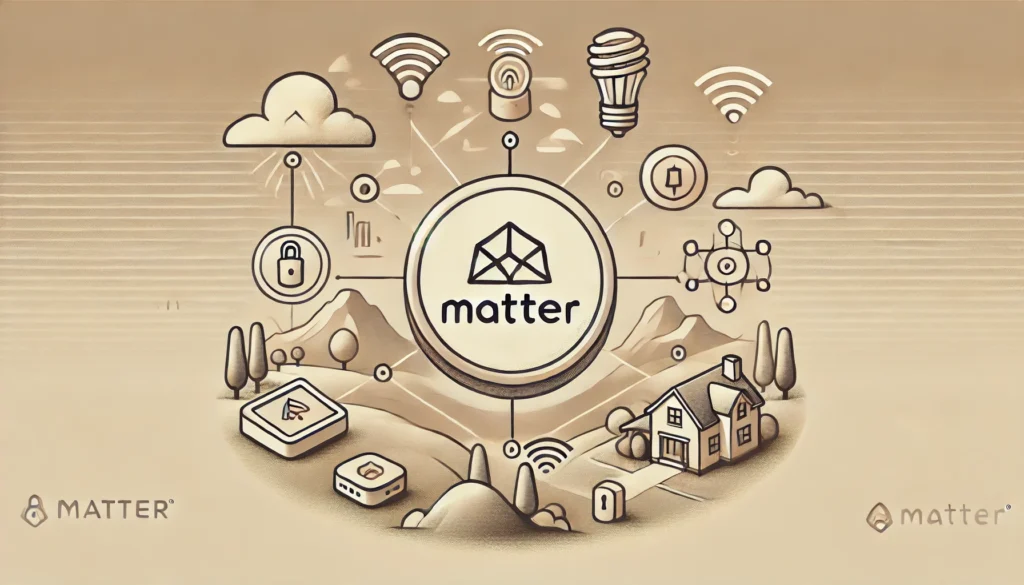
Matter logo, symbolizing unity and interoperability in smart home connectivity with surrounding smart devices
Matter is an application layer protocol developed by the Connectivity Standards Alliance (CSA). It aims to unify the smart home industry by providing a standardized language for devices to communicate over IP-based networks.
Deep Dive into Matter’s Technical Framework
Matter operates at the application layer, which means it defines how devices communicate and interpret commands over the network. It utilizes existing IP-based networking technologies like Wi-Fi and Ethernet and can also operate over Thread networks. By building on established IP infrastructure, Matter leverages proven security protocols and simplifies integration with cloud services.
Recent Developments and Industry Adoption
As of 2024, Matter has seen significant adoption from industry giants such as Apple, Google, Amazon, and Samsung. These companies have begun integrating Matter support into their devices and ecosystems, signaling a strong industry commitment to this standard. For instance:
- Apple has updated the HomePod mini and Apple TV 4K to support Matter.
- Google has rolled out Matter support for Nest devices.
- Amazon is updating Echo devices to be Matter-compatible.
Benefits of Matter
- Simplified Setup: Matter-enabled devices can be set up using a single app or voice assistant, reducing complexity.
- Enhanced Security: Implements robust security measures like encryption and authentication based on IP protocols.
- Cross-Brand Compatibility: Devices from different manufacturers can seamlessly interoperate.
Potential Challenges with Matter
- Limited Device Categories: Initially, Matter supports a limited range of device types, such as lighting, thermostats, and locks.
- Performance Overhead: Running over IP can introduce latency in some scenarios compared to protocols optimized for low-power devices.
- Security Concerns: While Matter emphasizes security, vulnerabilities in IP networks can pose risks if not properly managed.
Use Cases for Matter
- Home Automation: Simple tasks like controlling lights, thermostats, and locks across different brands.
- Voice Control Integration: Unified control through voice assistants like Siri, Alexa, and Google Assistant.
- Easy Expansion: Adding new devices to your smart home without worrying about compatibility.
Thread: The Backbone of Reliable Smart Networking
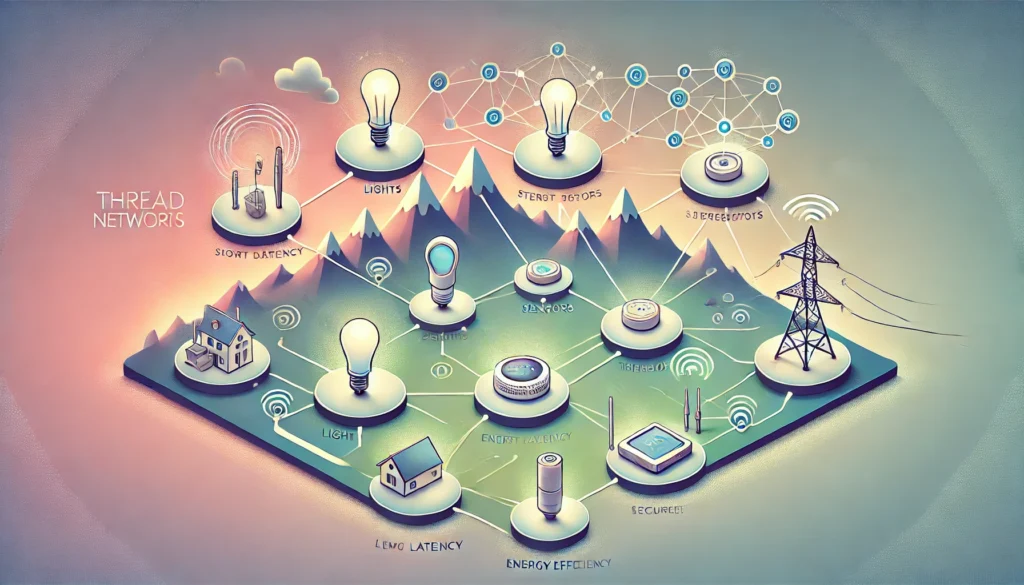
An illustration depicting the mesh networking topology of Thread networks.
Thread is a low-power, wireless mesh networking protocol designed specifically for Internet of Things (IoT) devices.
Technical Breakdown of Thread’s Network Layer
Thread operates at the network layer, handling the routing and delivery of data packets between devices. It is built upon the IEEE 802.15.4 standard, using the 2.4 GHz frequency band. Thread networks are IPv6-based, allowing direct internet connectivity and leveraging IP’s proven scalability and security features.
Features of Thread
- Low Latency and High Reliability: Mesh networking ensures multiple pathways for data, reducing latency and increasing reliability.
- Energy Efficiency: Designed for battery-powered devices, Thread minimizes power consumption.
- Scalability: Supports networks with hundreds of devices without significant performance degradation.
Role in Supporting Matter and Other Protocols
Thread provides the underlying network infrastructure for Matter devices that require low-power, wireless communication. It complements Wi-Fi and Ethernet by offering a mesh network that is ideal for IoT devices spread throughout a home.
How Thread Improves Device Communication and Network Resilience
In a Thread network, each device acts as a node that can send, receive, and relay data. If one node fails, data is automatically rerouted through other nodes, ensuring continuous network operation. This self-healing property enhances the resilience of the smart home network.
Potential Challenges with Thread
- Complex Setup: Setting up a Thread network may require a Thread Border Router, adding complexity.
- Interference: Operating in the 2.4 GHz band can lead to interference with Wi-Fi and other devices.
- Limited Awareness: Thread is less known to consumers, which might slow adoption.
Use Cases for Thread
- Large Homes: Provides robust connectivity for devices spread over large areas.
- Battery-Powered Devices: Ideal for sensors and devices that require low power consumption.
- Dense Device Networks: Supports a high density of devices without significant interference or congestion.
KNX: The Professional’s Choice for Home Automation
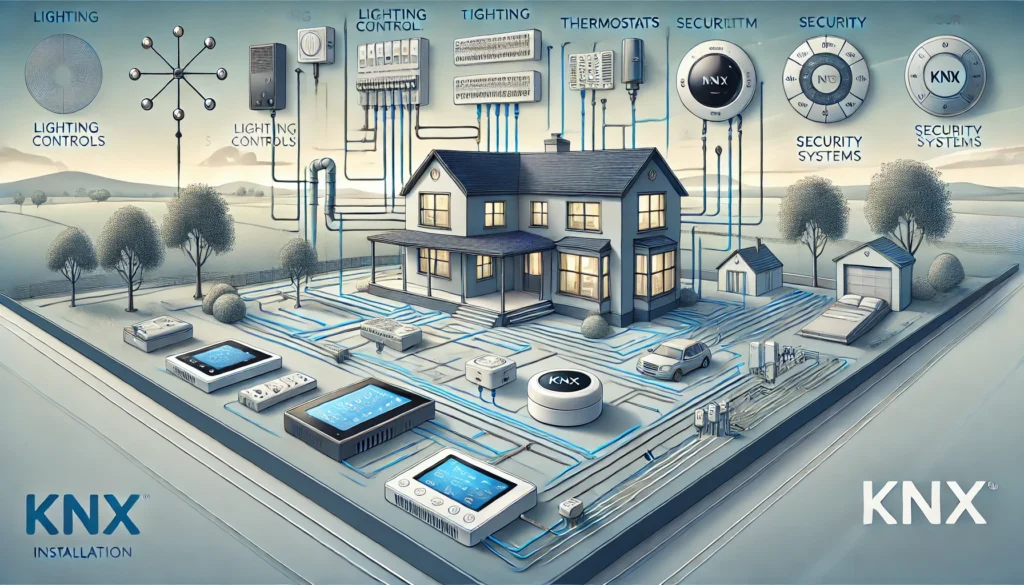
KNX: The Professional’s Choice for Home Automation
KNX is a globally recognized open standard for commercial and residential building automation.
Technical Overview of KNX’s Open Standard and Infrastructure
KNX primarily uses a twisted pair wiring system (KNX TP), but it also supports communication over IP (KNX IP), radio frequency (KNX RF), and power line (KNX PL). KNX operates across the physical, data link, network, transport, and application layers, making it a comprehensive automation solution.
Benefits of KNX
- Scalability and Flexibility: Supports large-scale installations with complex automation requirements.
- Reliability: Wired connections provide stable communication, unaffected by wireless interference.
- Interoperability: Over 500 manufacturers produce KNX-certified products, ensuring a wide range of compatible devices.
Integration Possibilities with Wireless Technologies
KNX can integrate with wireless technologies through gateways and interfaces. For instance, a KNX system can communicate with Matter or Thread devices via a KNX-IP router, enabling hybrid installations that leverage both wired reliability and wireless flexibility.
Potential Challenges with KNX
- Cost: Installation and equipment can be expensive, making it less accessible for small-scale residential projects.
- Complexity: Requires professional installation and programming.
- Lack of DIY Support: Not ideal for consumers who prefer do-it-yourself setups.
Use Cases for KNX
- Commercial Buildings: Ideal for offices, hotels, and large-scale commercial projects requiring robust automation.
- Luxury Homes: Suitable for high-end residential properties with extensive automation needs.
- Complex Automation Scenarios: Manages integrated control over HVAC, lighting, security, and more.
Comparing the Standards
Detailed Comparison Chart
| Feature | Matter | Thread | KNX |
|---|---|---|---|
| Layer | Application Layer Protocol | Network Layer Protocol | Full Stack Protocol (Physical to Application) |
| Communication Medium | IP Networks (Wi-Fi, Ethernet, Thread) | Mesh Networking (IEEE 802.15.4 over 2.4 GHz) | Twisted Pair Wiring, IP, RF, Power Line |
| Primary Use Cases | Consumer Smart Home Devices | IoT Device Networking | Professional and Complex Installations |
| Key Benefits | Interoperability, Simplified Setup, Security | Low Latency, Resilience, Energy Efficiency | Scalability, Reliability, Flexibility |
| Challenges | Limited Initial Device Support, Performance | Setup Complexity, Interference | Cost, Complexity, Professional Installation |
| Integration | Works over Thread and Wi-Fi Networks | Supports Matter Devices at Network Layer | Integrates with IP Networks and Wireless Protocols |
How They Complement Each Other
- Matter and Thread: Matter uses Thread as one of its network layers, combining Thread’s efficient mesh networking with Matter’s universal application protocol.
- KNX and Matter/Thread: KNX systems can integrate with Matter and Thread devices through gateways, allowing for a hybrid system that benefits from KNX’s reliability and Matter’s interoperability.
Flowchart of Device Communication Using Matter and Thread
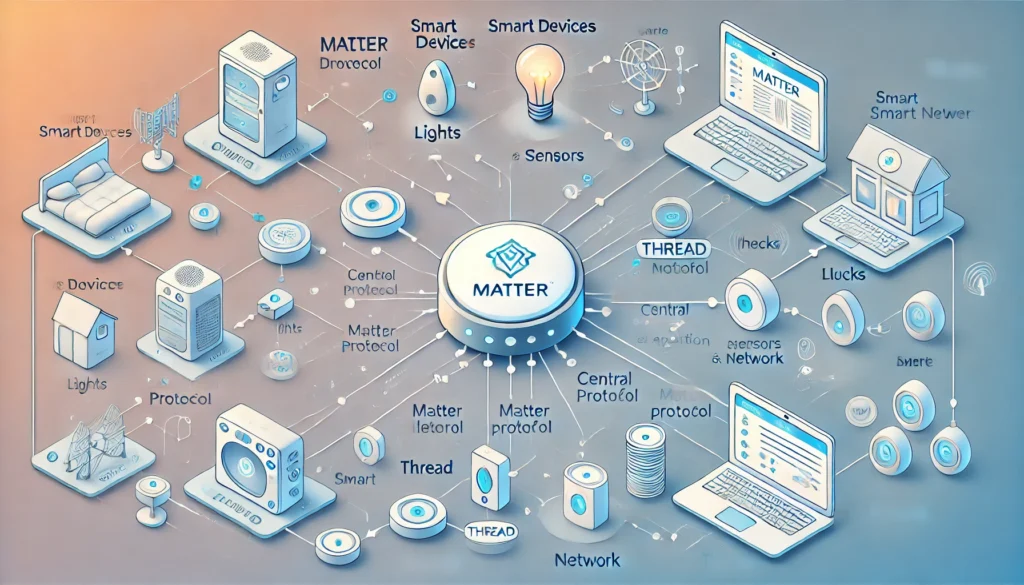
A flowchart illustrating how Matter devices communicate over a Thread network within a smart home setup.
Case Studies
Case Study 1: Seamless Smart Home Upgrade with Matter and Thread
Background: A homeowner wants to upgrade their smart home with devices from different brands without the hassle of multiple apps and hubs.
Solution: By choosing Matter-compatible devices that operate over a Thread network, the homeowner achieves seamless interoperability. Devices like smart bulbs, thermostats, and door locks from different manufacturers communicate effortlessly, controlled through a single app or voice assistant.
Outcome: Simplified setup and control, improved network reliability, and enhanced security.
Case Study 2: Reliable Automation in Luxury Apartments with KNX
Background: A luxury apartment complex requires an advanced automation system for lighting, HVAC, security, and energy management.
Solution: A KNX system is implemented, utilizing twisted pair wiring throughout the building. The system integrates various functions into a centralized control platform, with the option to interface with IP networks for remote access.
Outcome: Robust and reliable automation, energy efficiency, and scalability for future expansion.
Case Study 3: Hybrid Integration in Commercial Buildings Using KNX and Matter
Background: A commercial building seeks to modernize its automation system, integrating both wired and wireless technologies.
Solution: The building employs a KNX backbone for critical systems and integrates Matter and Thread devices for flexible control of lighting and environmental sensors. Gateways connect the KNX system with the wireless devices, allowing centralized management.
Outcome: Enhanced functionality, flexibility in device selection, and a future-proof system ready for emerging technologies.
Addressing Potential Challenges and Future Trends
Potential Challenges Across Standards
- Security Risks: As devices become more interconnected, the potential attack surface increases. Ensuring all devices are updated and secured is critical.
- Compatibility Issues: While standards aim for interoperability, discrepancies in implementations can lead to compatibility problems.
- Market Fragmentation: New standards may emerge, potentially fragmenting the market further.
Future Trends
- Integration of AI and Machine Learning: AI can enhance automation by learning user behaviors and optimizing device performance.
- Edge Computing: Processing data locally on devices can improve response times and reduce reliance on cloud services.
- Sustainability Focus: Energy-efficient protocols like Thread will become more important as consumers prioritize sustainability.
Conclusion
The convergence of Matter, Thread, and KNX represents a significant step toward a more unified and efficient smart home ecosystem. By understanding the technical aspects, benefits, and challenges of each standard, consumers and professionals can make informed decisions that enhance their smart home setups.
Future Outlook on Smart Home Connectivity
As adoption of these standards grows, we can expect:
- Greater Device Compatibility: A broader range of devices working together seamlessly.
- Improved User Experience: Simplified setup processes and unified control interfaces.
- Advanced Automation Capabilities: Integration of AI and machine learning for smarter homes.
Call to Action
Now is an exciting time to invest in smart home technology. Whether you’re a homeowner looking to upgrade your living space or a professional in the industry, staying informed about these standards is crucial. Consider exploring the resources below to deepen your understanding and take the next steps toward implementing or enhancing your smart home system.
Further Exploration
For readers interested in delving deeper into smart home technologies, here are some additional resources:
Articles and Tutorials
- “Getting Started with Matter: A Comprehensive Guide” by Smart Home Weekly
- “Implementing Thread Networks in Your Home” by IoT Tech Magazine
- “KNX Installation Best Practices” by Building Automation Today
Product Recommendations
- Matter-Compatible Devices:
- Philips Hue Smart Lighting
- August Smart Locks
- Eve Energy Smart Plugs
- Thread-Enabled Products:
- Google Nest Thermostat
- Nanoleaf Essentials Bulbs and Lightstrips
- Apple HomePod mini
- KNX Certified Products:
- ABB i-bus KNX Sensors and Actuators
- Siemens KNX Switches and Dimmers
- Gira KNX Touch Panels
Online Communities and Forums
- r/smarthome on Reddit: A community for discussing smart home setups and getting advice.
- KNX User Forum: A place to ask questions and share knowledge about KNX installations.
- Matter Developers Group: For those interested in the technical development of Matter-compatible devices.
Official Websites
- Connectivity Standards Alliance: https://csa-iot.org/
- Thread Group: https://www.threadgroup.org/
- KNX Association: https://www.knx.org/
